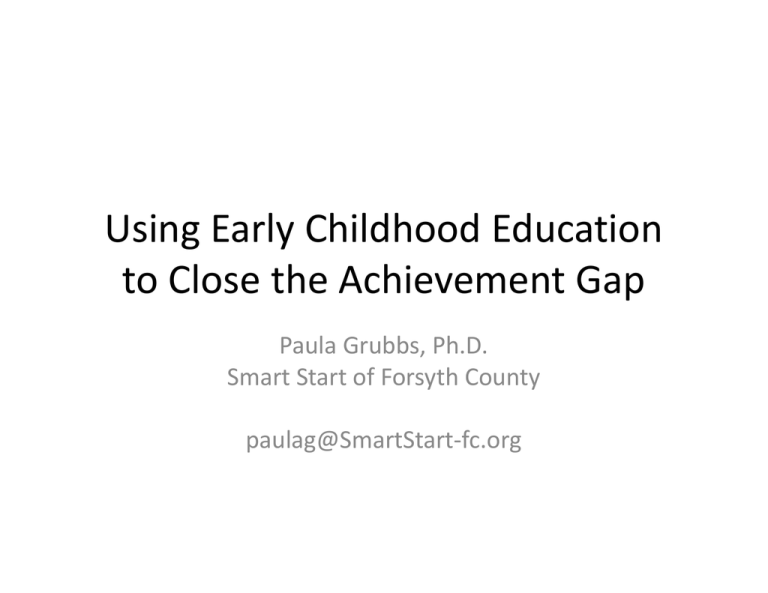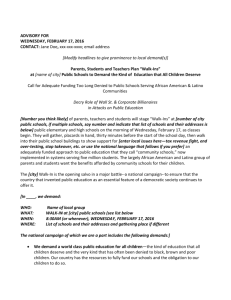Using Early Childhood Education to Close the Achievement Gap Paula Grubbs, Ph.D. Smart Start of Forsyth County
advertisement

Using Early Childhood Education to Close the Achievement Gap Paula Grubbs, Ph.D. Smart Start of Forsyth County paulag@SmartStart‐fc.org What is the Achievement Gap? What is the Achievement Gap? Who is impacted? Who is impacted? • African American Students African American Students • Latino Students Should we be examining ethnicity or SES? African American Students African American Students Family Structure • • • • • • • • Nearly 60 % of poor African American families with children have at least one working family member. Fewer than 40 % of all African American children live with two parents, compared to about 75% of White children. to about 75% of White children. 50% of African American children live with only their mother. African American children are almost 3 times as likely to live with their mother only as are White children. African American children are more than twice as likely as other children to live African American children are more than twice as likely as other children to live with neither parent. About 5 % of African American children live with grandparents and just over 2% live with other relatives. African American children are 4 times as likely as White children to be in foster African American children are 4 times as likely as White children to be in foster care. African American children are 7 times as likely as White children to have a parent in prison. African American Students African American Students Socioeconomic Status • • • • • • • • • In 2009, 15.5 million children – ll h ld more than one in five – h f were poor. Children experienced the steepest single year rise in poverty since 1959. African American children are three times as likely to be poor (35%) as White children (12%). African American children are more than three times as likely as White children to live in extreme poverty: half of the poverty level or less ($11,025 for a family of four). African American children under five are the poorest group. Forty‐two percent of them are poor compared to 14 % of White children. These young African American children are more than three times as likely as White children to live in extreme poverty. Forty percent of African American children are born poor, compared to 8% of White children. More than two‐thirds of African American children born poor will be persistently poor for at least half of their childhoods. African American children are seven times more likely than White children to be y persistently poor. African American Students African American Students Early Childhood Development & School Readiness • African American Children Fall Behind Early On Af i A i Child F ll B hi d E l O • At nine months African American babies score lower on measures of cognitive development than White babies. • At 24 months the gap in cognitive development has more than tripled between Af i African American babies and White babies. A i b bi d Whi b bi • At 4‐years‐old African American children scored significantly behind White children in their proficiency in letter, number and shape recognition. • • • • Too Many African American Children Enter School Behind African American children are enrolled in pre‐kindergarten programs at a higher rate than White children, but the programs often are of lower quality. g , g / g On average, African American children arrive at kindergarten and/or first grade with lower levels of school readiness than White children. African American children spend more time on average watching television daily, are less likely to have regular mealtimes and have far fewer books than White children African American Students African American Students Education • • • The overrepresentation of poor and minority children in grade retention, out‐of‐school p p y g , suspensions and special education have interacted with low teacher expectations to contribute to these children’s discouragement, low self esteem and disengagement from school. Poor African American children experience the least qualified teachers, worst education facilities and fewest resources. facilities and fewest resources. African American children experience too few African American teachers in the classroom. Only 7% of public school teachers today are B African American and only 2% are African American males. Retention, Suspension, Expulsion and Corporal Punishment , p , p p • African American children are 2.5 times as likely as White children to be held back or retained in school. The Achievement Gap • African American children continue to fall further and further behind as they progress yp g through school: – – – – In fourth grade 85 % cannot read or do math at grade level. In eighth grade 87 % cannot read at grade level and 88 % cannot do math at grade level. In twelfth grade 84 % of those African American students who have not dropped out of school cannot read at grade level and 94 % cannot do math at grade level cannot read at grade level and 94 % cannot do math at grade level. African American students consistently score the lowest of any racial/ethnic student group on every section of both the SAT and the ACT college entrance exams. • Children’s Defense Fund. (2011). Portrait of Inequality 2011: Black children in America. Latino and Latino American Students Latino and Latino American Students • • • • • • • • • • • The economic situation of parents plays an important role in affecting the poverty status of children. children. Among Latino children with an unemployed parent, 43.5% lived in poverty in 2010. Among Latino children in married‐couple families, the 2010 poverty rate was 25.3%, less than half the size of the poverty rate among children in female‐headed families (57.3%). Among Latino children in male‐headed families, 32.7% lived in poverty. Latino children in families with a college‐educated parent have the lowest poverty rates overall— h ld f l h ll d d h h l ll 8.7% in 2010. Among Latino children in families with a parent who has some college experience, 21.8% lived in poverty. By contrast, nearly half (48.3%) of Latino children with parents that have a high school degree or y y ( ) p g g less lived in poverty in 2010. The nativity of parents is an important factor in explaining poverty rates among Latino children. In 2010, the poverty rate among Latino children with immigrant parents was 40.2%, while it was 27.6% among Latino children with U.S.‐born parents. Childhood poverty rates are also linked to the age of the child. p y g Among Latino children younger than age 5, 37.6% lived in poverty in 2010. Among those between the ages of 5 and 12, 35.9% lived in poverty, while among those ages 13 to 17, 30.1% lived in poverty. Latino and Latino American Students Latino and Latino American Students • • • • • A newly released report on student achievement finds that members of the nation's second largest ethnic group are still woefully underperforming their white counterparts. While scores have increased for both groups, Latino students lag by the same amount today as they did in 1990, which means that the achievement gap between Latino and white students has been largely unchanged for the past two decades. The report analyzes tests given to fourth and eighth graders in math and reading in 2009. Overall, on a national level, Latino students scored about 20 points — or two whole grade levels — lower on the National Assessment of Educational Progress (NAEP) scale. (A common rule of thumb among education advocates is that 10 points on the NAEP scale is equivalent to one grade level.) Read more: http://www.time.com/time/nation/article/0,8599,2079429,00.html#ixzz1 pCiQ7LC6 The 4 Americas The 4 Americas • For the first time, in 2011 more infants of color were born in America than White, non‐ Hispanic infants. Fifteen year olds in the United States rank 17th among industrialized nations in reading: • Asian students rank 2nd, behind China and ahead of Korea. • White students rank 7th, behind Singapore and ahead of Canada. • Latino and Latino American students rank 43rd, behind Lithuania and ahead of Turkey. • African American students rank 49th, behind Serbia and ahead of Bulgaria. Fifteen year olds in the United States rank 31st among industrialized nations in math: • Asian students rank 13th, behind Macao and ahead of New Zealand. , g • White students rank 16th, behind Belgium and ahead of Australia. • Latino and Latino American students rank 43rd, behind Croatia and ahead of Dubai. • African American students rank 52rd, behind Uruguay and ahead of Chile. Fifteen year olds in the United States rank 23rd among industrialized nations in science: Asian students rank 7th behind Korea and ahead of New Zealand • Asian students rank 7th, behind Korea and ahead of New Zealand. • White students rank 9th, behind New Zealand and ahead of Canada. • Latino and Latino American students rank 44th, behind Dubai and ahead of Israel. • African American students rank 52nd, behind Bulgaria and Uruguay and ahead of Romania. • • Comparisons are drawn from the 2009 Program for International Student Assessment (PISA). Full results can be found at: http://nces.ed.gov/surveys/international/ide/. Children’s Defense Fund (2012). The State of America’s Children Handbook. 2012 Poverty Guidelines 2012 Poverty Guidelines • Persons in Family y 1 2 3 4 5 6 7 8 • Poverty Guideline y $11,170 $15, 130 $19,090 $23,050 $27, 010 $30, 970 $34, 930 $38,890 Manifestations of Diversity in the Classroom l • What What are ways diversity is apparent in your are ways diversity is apparent in your classroom? Why is Language Development Important? • 30 Million Word Gap 30 Million Word Gap • Benefits of Early Childhood Education • What does quality mean? h d li ? Benefits of Early Childhood Education • • • • • • The High/Scope Perry Preschool study, which was conducted by the High/Scope Educational Research Foundation documented a return to society of more than $17 for every tax dollar Research Foundation, documented a return to society of more than $17 for every tax dollar invested in the early care and education program. The study of the effects of high‐quality early care and education on low‐income three‐ and four‐year‐olds shows that, "adults at age 40 who participated in a preschool program in their early years have higher earnings, are more likely to hold a job, have committed fewer crimes, and are more likely to have graduated from high school " graduated from high school. Other findings of note: * More of the group who received the early education graduated from high school than the non‐program group (65 percent vs. 45 percent). For females, the difference was 84 percent vs. 32 percent. * Not only did the early education program group outperform the non‐program group during their early years, they were still out‐performing them on school achievement tests between ages nine and 14 and on literacy tests at ages 19 and 27. * More of the group in the early education program were employed at age 40 (76 vs. 62 percent), and their median annual earnings were more than $5,000 higher than the non‐ percent), and their median annual earnings were more than $5,000 higher than the non program group. * The group receiving the early education program had significantly fewer arrests than the non‐program group, and fewer of the females required treatment for mental impairment or had to repeat a grade. – “Study Study Shows Benefits of Quality Early Childhood Education Shows Benefits of Quality Early Childhood Education”. Techniques, 80 (2). February 2005. Techniques 80 (2) February 2005







